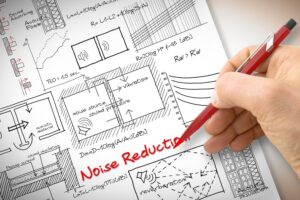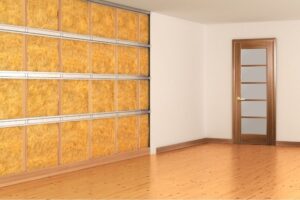Achieving optimal soundproofing in your home has become essential for many homeowners in today’s noisy urban environments. As cities grow increasingly populated and residential structures are built in close proximity, the issue of noise disturbances has escalated significantly. Many newly constructed homes are made with lighter materials, such as stud walls featuring gypsum board, which often fall short in preventing sound transmission. This results in disruptive noise levels that can interfere with daily activities, emphasizing the need for effective soundproofing strategies to cultivate a peaceful and tranquil living environment.
Homeowners increasingly desire to enjoy their spaces without interruptions and to minimize conflicts with neighbors over noise complaints. Consequently, the demand for innovative and effective soundproofing solutions has surged. With the rise of remote work and home entertainment systems, establishing a serene atmosphere has never been more critical. External noise from busy streets, ongoing construction, or even rowdy neighbors can drastically affect one’s quality of life, prompting many to explore soundproofing as a feasible remedy.
The annoyance of noisy neighbors stands out as the primary reason for homeowners considering soundproofing their residences. The yearning for a personal haven free from intrusive noise is fueling heightened interest in soundproofing solutions, particularly in urban areas with dense populations. Homeowners are eager to reclaim their peace and ensure their homes serve as a refuge from the surrounding clamor.
Unlock the Top Benefits of Soundproofing Your Living Space
- Enhance your home theater experience for immersive movie nights
- Establish a focused and productive home office atmosphere
- Create tranquil bedrooms that support restful sleep for young children
- Diminish disturbances from traffic noise or nearby train tracks
- Reduce noise pollution if your home is under an aircraft flight path
- Assist shift workers in achieving uninterrupted rest
- Design an optimal practice space for musicians
Implementing soundproofing solutions not only enhances your quality of life but also creates a more harmonious living environment. Additionally, effective soundproofing can boost your property’s market value, making it more appealing to prospective buyers in the future.
Beyond improving comfort, soundproofing also contributes to the overall energy efficiency of your home, facilitating consistent heating and cooling throughout your space.
Explore the Multifaceted Advantages of Soundproofing Your Home
With soundproofing, you can indulge in your favorite music or movies at any hour without disturbing others in your household or neighborhood. This newfound freedom not only enhances your overall enjoyment but also encourages a more peaceful coexistence with those around you.
Moreover, the challenges of remote work can be exacerbated by constant interruptions from household noise. By soundproofing your home office, you can cultivate a focused workspace, enabling you to participate in conference calls or webinars without distractions from family members or general household activities.
Maximize the Soundproofing Potential During Your Home Construction
The most effective and cost-efficient way to achieve a soundproofed room is to incorporate soundproofing measures during the initial construction or renovation of your home. By prioritizing soundproofing from the outset, you can avoid the high costs associated with retrofitting later on.
When planning your home construction or renovation, ensure that high-quality soundproofing techniques and materials are integrated into the design. Utilizing options such as acoustic plaster, soundproofing membranes, and mass elastic vinyl can significantly boost your home’s resistance to sound transmission.
If you require a soundproofed area, such as a recording studio, additional planning is necessary to implement a “room within a room” design. This method effectively isolates sound and prevents external noise from interfering with your audio projects.
Deepening Your Understanding of Noise for Effective Soundproofing
Noise arises from sound waves, which can be defined as energy waves that propagate through various mediums. It’s important to understand that sound can be classified into two primary categories: airborne sound and impact sound.
Understanding Airborne and Impact Sound for Tailored Soundproofing Solutions
Airborne sound consists of sound that travels through the air, encompassing everyday noises such as conversations, television sounds, traffic, household appliances, music, and even barking dogs. Recognizing this type of noise is crucial for implementing effective soundproofing strategies.
Conversely, impact sound is produced when objects make contact with surfaces within your home. Examples include the sound of closing doors, the movement of furniture, and footsteps on hard flooring. To effectively mitigate these sounds, soundproofing strategies must be employed to control the transmission of sound waves.
To effectively stop or reduce the transmission of sound, it is essential to diminish the energy or intensity of the sound waves. This can be accomplished through various soundproofing techniques and materials tailored to your specific circumstances.
In-Depth Guide to Essential Soundproofing Techniques
Embark on your soundproofing journey by meticulously inspecting your walls for any gaps or weaknesses. Employ acoustic sealant to seal any cracks or openings. Treat soundproofing with the same level of importance as waterproofing; its effectiveness hinges on the integrity of its weakest points.
A useful analogy is to imagine rolling down your car window and hearing loud external noises. If you roll it back up but leave a small gap, noise will still penetrate; however, closing the window completely will eliminate sound intrusion.
To enhance soundproofing, increase the mass of your walls by incorporating high-mass or high-density products. This added mass will enhance the wall’s capacity to absorb sound energy and vibrations effectively. Without this improvement, merely adding mass might yield minimal results.
Consider integrating acoustical insulation between wooden battens in your walls to significantly decrease sound reverberation. This addition will aid in absorbing sound waves and minimizing their transmission throughout your home.

Employ a Variety of High-Mass Materials for Optimal Soundproofing Results
Different materials possess unique effectiveness in addressing various sound frequencies. Therefore, utilizing a combination of high-mass materials will yield superior results compared to relying on multiple materials of the same type. Understanding the intricacies of soundproofing materials is essential for success.
Blocking Techniques: To effectively block sound waves from infiltrating a space, consider implementing double-glazed windows, sealing cracks and holes in walls, and utilizing door sweeps to prevent sound from penetrating beneath doors and around window frames. These measures create a formidable barrier against unwanted noise.
Absorbing and damping are two closely related concepts in soundproofing. Absorbing refers to materials that “soak up” sound vibrations, such as carpets, cork flooring, acoustic foam, or ceiling insulation. In contrast, damping involves stopping sound energy from vibrating and propagating further; for instance, a solid wood door is more effective than a particleboard door in this regard.
Decoupling Techniques: This technique involves creating a separation between two sides of a structure to prevent direct contact, thereby minimizing the transfer of vibrations from one side to the other. It is particularly effective for isolating sound on one side of a wall and preventing it from traveling through to the other side.
Consider which rooms in your home could benefit from soundproofing. Any space that you believe would thrive with reduced noise levels is an ideal candidate.
If you are in the midst of building or renovating, integrating additional soundproofing products will elevate your living experience. A home that effectively blocks outside noise and has been acoustically treated provides a more comfortable atmosphere for all inhabitants.
Expert Strategies for Soundproofing a Professional Recording Studio
If your objective is to create a professional recording studio or sound booth, the most effective method is to construct a “room within a room.”
This design ensures that the interior room remains physically disconnected from the external environment, which is crucial for effective decoupling. By preventing sound vibrations from traveling through walls, you can achieve optimal sound isolation.
Both the inner and outer rooms should be constructed using dense materials such as acoustic plasterboard and should include acoustic insulation or foam between the walls. Moreover, sealing the room with acoustic sealant is essential to eliminate any gaps around the door frame, effectively blocking unwanted noise and external sounds.
When soundproofing a home theatre room, effective measures can be implemented using acoustic gypsum board and noise-resilient mounting clips. These components work synergistically to create a robust sound barrier between the gypsum board and the stud framing.
Enhancing sound absorption in the home theatre can be achieved by incorporating high-quality carpets and upholstered furniture, which will help to reduce echoes and create a more immersive viewing experience.
Elevate Your Productivity with a Soundproof Home Office
In a home office, the last thing you need is disruptive noise detracting from your concentration. Noisy neighbors, playful children, lawnmowers, or barking dogs can pose significant distractions that hinder your productivity.
To create an effective soundproof home office, you can implement the same strategies employed in soundproofing a home theatre. By utilizing high-quality soundproofing materials, you can cultivate an environment that promotes focused work.
Transform Your Bedrooms into Tranquil Sanctuaries through Soundproofing
A bedroom should serve as a sanctuary where minimal noise is essential for relaxation and restorative sleep. The absence of disturbances is critical for ensuring a good night’s sleep, and reducing outside noise can significantly enhance your overall sleep quality.
For effective soundproofing in bedrooms, it is often sufficient to install a medium-density acoustic insulation mat within the interior walls, complemented by a higher-density insulation mat in the exterior walls. Additionally, employing a draft stopper or door sweep on the bedroom door can further reduce noise intrusion.
Addressing Soundproofing Challenges in Existing Rooms
Standard gypsum board walls frequently lack adequate sound reduction due to their limited thickness. The space between the boards and the wall cavity can create an echo chamber, allowing sound waves to bounce around and easily pass through the wall studs.
Depending on your desired level of soundproofing and available budget, we recommend the following strategies.
Option 1: Embrace Open Space with Soft Furnishings for Sound Reduction
To effectively diminish sound in a room or area, consider embracing an open-plan design. Utilize soft furnishings such as upholstered furniture, rugs, carpets, and blackout curtains or drapes. All these elements contribute to lessening the transmission of sound waves, creating a more peaceful atmosphere.
Floor coverings play a crucial role in absorbing sound, while curtains effectively block sound from seeping through windows, further enhancing your soundproofing efforts.
Option 2: Enhance Sound Absorption with Acoustic Treatments
If open space modifications prove insufficient, you can enhance soundproofing by adding sound-absorbing ceiling tiles and exterior acoustic tiles to walls. If carpeting is a consideration, employing an acoustic underlayment on the floor can significantly improve sound insulation, especially in apartments with neighbors below.
Option 3: Tackle External Noise Sources for Enhanced Peace
If external noise is a significant issue—such as living near a bustling street or having boisterous neighbors—you may need to implement structural changes to your walls and doors. Consider adding a layer of acoustic plasterboard over existing walls and replacing hollow doors with solid-core doors to improve sound insulation.
Additionally, incorporating a draft stopper will help prevent noise from seeping under the door, further enhancing the soundproofing of your bedroom.
Option 4: Comprehensive Wall Insulation for Ultimate Soundproofing
The next effective step involves removing the current gypsum board, filling the wall cavity with acoustic wall insulation, and then re-plastering it with acoustic gypsum board. This method provides a robust sound barrier, significantly reducing noise transmission.
Option 5: Constructing Acoustic Walls for Superior Sound Isolation
For the highest level of soundproofing, consider building an acoustic wall, similar to the construction of a recording studio. This process requires a contractor to frame a new wall detached from existing walls, ensuring that wall cavities are filled with appropriate insulation material and covered with acoustic gypsum board.
Additionally, incorporating mass elastic vinyl can further enhance sound insulation. Don’t forget to install quality carpeting and an acoustic underlayment on the floors to complete your soundproofing measures.
Consult Professionals for Customized Soundproofing Solutions
For tailored advice on selecting the most effective soundproofing materials and techniques, consider reaching out to professionals who can provide insight into your specific noise challenges. Explore expert recommendations for Brisbane soundproofing solutions that can significantly transform your living environment.
The Article Soundproofing Your Home was found on https://limitsofstrategy.com
The Article Soundproofing Your Home for Ultimate Peace and Quiet First Appeared ON
: https://ad4sc.com




Your exploration of soundproofing in urban environments really resonates with me, particularly as someone who has experienced the challenges firsthand of living in a densely populated area. It’s interesting how much our living environments can shape our daily lives and overall well-being—especially with the constant backdrop of urban noise that seems almost impossible to escape.
I know exactly what you mean about the challenges of living in a densely populated area. There’s something almost dizzying about the constant hum of a city—traffic, construction, voices. It’s fascinating how that background noise can seep into our daily lives, affecting everything from our mood to our sleep quality. I’ve noticed it impacts my focus, too. On particularly noisy days, I struggle to concentrate on simple tasks, which makes me appreciate quieter spaces when I can find them.
I appreciate you sharing your experience. Living in a densely populated area brings its own set of challenges, and the everyday presence of noise can wear on you in ways that are often overlooked. It’s fascinating to consider how much urban sound shapes our lives.
You raise an interesting point about how urban sound affects our daily lives. It’s so true that in densely populated areas, we’re constantly enveloped in a symphony of noises—from honking horns to distant sirens, and even the chatter of neighbors. Sometimes, it feels like we become desensitized to it all, but then a moment of sudden quiet can really highlight just how pervasive that backdrop of sound is.
You raise a compelling point about the growing need for effective soundproofing solutions in our increasingly dense urban environments. It’s interesting to see how the issue of noise pollution has transformed from a mere annoyance to a genuine concern that impacts our mental and emotional well-being. I often find myself reflecting on how the design of our living spaces has evolved—or perhaps devolved—in response to urban demands.
You’ve touched on a pressing concern that many homeowners, including myself, have faced in recent years. The dynamics of urban living can indeed be challenging, particularly as noise pollution has become an omnipresent aspect of our daily environments. I’ve found that the issue of soundproofing isn’t just about finding peace and quiet—it also plays a crucial role in our overall well-being and mental health.
You’ve brought up such a relatable point! Living in a busy city, I’ve definitely noticed how noise can intrude on everyday life. I remember my friend soundproofed his home studio with acoustic panels and heavy curtains, and it made a huge difference for his music production. It’s interesting how soundproofing isn’t just about peace and quiet anymore, but also about creating a comfortable, functional space for remote work and relaxation. I wonder if advanced technologies like sound masking or even noise-canceling systems for the entire home will become more common. It feels like an essential evolution for modern living! What has everyone else found helpful in managing noise?
You’ve hit on something so crucial with your experience in a busy city. Noise can really become a part of the background that we stop noticing, but it can also be a huge source of stress, especially if you’re trying to focus or unwind. Your friend’s use of acoustic panels and heavy curtains is such a smart move. It’s amazing how those elements can transform a space—not just for music production, but for everything from work calls to movie nights.
You’ve hit on a super relatable point! It’s crazy how much noise pollution can affect our daily lives, especially with so many people moving to urban areas. I recently tried soundproofing my home office because of constant street noise—it made a big difference! I used some acoustic panels and even added a rug, which helped absorb sound better. I think it’s fascinating how simple changes can really transform a space. Also, with more people working from home, I wonder if we’ll see more innovative design trends focused on soundproofing in new constructions. Anyone else here tackled sound issues in their homes? What worked for you?